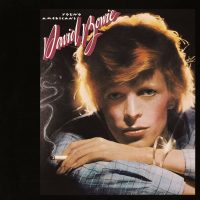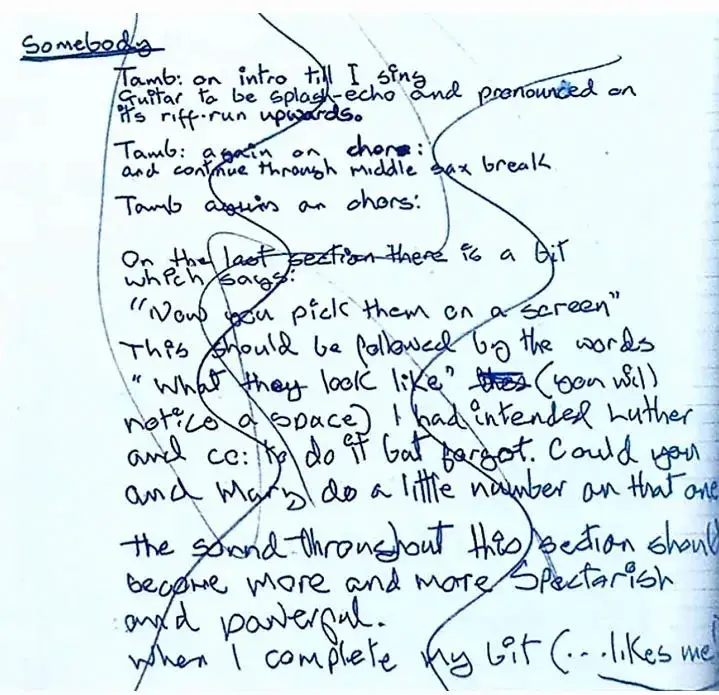 Written by: David Bowie
Written by: David Bowie
Recorded: August, December 1974
Producers: Tony Visconti, Harry Maslin
Released: 17 February 1975
Available on:
Young Americans
I’m Only Dancing (The Soul Tour 74)
Personnel
David Bowie: vocalsCarlos Alomar: electric guitar
Mike Garson: piano, synthesizer
David Sanborn: alto saxophone
Willie Weeks: bass guitar
Andy Newmark: drums
Luther Vandross, Ava Cherry, Robin Clark: vocals
‘Somebody Up There Likes Me’ is the fifth song on Young Americans, David Bowie’s 1975 soul album.
The song was adapted from ‘I Am Divine’, a December 1973 outtake recorded by the Astronettes, Bowie’s backing singers for The 1980 Floor Show. Although the title ‘Somebody Up There Likes Me’ was taken from the 1956 biopic of boxer Rocky Graziano, Bowie’s song focused on the cult of celebrity, and its encroachment into the world of politics. Bowie was increasingly interested in the power of figureheads in society, and shortly after the album’s release indicated a desire to enter politics as well as a deepening fascination with totalitarianism.
‘Somebody Up There Likes Me’ is a ‘Watch out mate, Hitler’s on his way back’… it’s your rock and roll sociological bit.
New Musical Express, August 1975
At 6:34, ‘Somebody Up There Likes Me’ is the longest song on Young Americans, although the studio outtake ‘John, I’m Only Dancing (Again)’ crossed the seven-minute mark. It is also one of Bowie’s wordiest songs, with densely-packed verses and complex backing vocal arrangements.
There was no point doing a straightforward take on American soul music because that had been done already. I just wanted to put this spin on it. And even the tunes themselves, you couldn’t really envisage any American soul artist doing any of those songs. But they paid homage to the soul sound. Things like ‘Somebody Up There Likes Me’, the format of it isn’t straight rhythm and blues at all by any means. Things like ‘Win’, the chord structures are much more of a European thing than an American thing. But it imbued the muscular qualities of soul music pretty accurately, and I got these pretty heavyweight American musicians working on it. It gave it some sound of a kind of a fake authenticity to it. It really was a plastic soul album.
The David Bowie Story, BBC Radio 1
Somebody Up There Likes Me one of the working titles for the album, along with The Young American, Shilling The Rubes, Dancin’, One Damn Song, The Gouster, and Fascination.
Bowie performed ‘Somebody Up There Likes Me’ occasionally during the Soul Tour in late 1974. It was first played on 10 October at the Dane County Coliseum in Madison, Wisconsin.
A live version from Bowie’s 20 October 1974 show at Detroit’s Michigan Palace can be heard on the 2020 album I’m Only Dancing (The Soul Tour 74).
In the studio
Young Americans was recorded in four separate stages: sessions in August and November 1974 at Sigma Sound Studios in Philadelphia, Pennsylvania; more at New York’s Record Plant in December; and one final session with John Lennon in January 1975 at New York’s Electric Lady Studios.
‘Somebody Up There Likes Me’ was first recorded at Sigma in August 1974, along with (in their original titles) ‘The Young American’; ‘Shilling The Rubes’; ‘Lazer’, a reworking of ‘I Am A Laser’; ‘After Today’; ‘I’m Only Dancing’, later retitled ‘John, I’m Only Dancing (Again)’; ‘Never No Turnin’ Back’, later re-recorded as ‘Right’; ‘Who Can I Be Now?’; ‘Come Back My Baby’, eventually released as ‘It’s Gonna Be Me’; and ‘Can You Hear Me’, sometimes known as ‘Take It In, Right’.
There was jamming of ideas, but not with everybody. We would do a certain amount of arrangements with guitar, bass and drums and then you would consider an invited guest like keyboards and electric lead guitar. Then after that you would do background vocals and after that lead vocals.That’s the way the sessions went, like that, calm. ‘Somebody Up There Likes Me’, ‘Win’… everything has its place. And, the development of it, Bowie would say, ‘Let’s not put that part in yet – let’s wait.’ So there would be an introduction, the instruments come in. Bowie doesn’t want to hear the same thing in the beginning as at the end – there has to be some development in the song. His ear is acute to the development of the song and he wants the people that will give him the potential for development.
David Bowie: Ultimate Record Collection (Uncut)
More overdubs for ‘Somebody Up There Likes Me’ and ‘Right’ were recorded at the Record Plant in December 1974, along with the new songs ‘Fascination’, and ‘Win’. Tony Visconti produced the sessions, with Harry Maslin engineering.
The original reason why the Record Plant – where I was working at the time – put me on his project was because I was kinda the R&B guy, and Young Americans was an R&B-influenced album, so we started on the new songs, and he took me into the inner circle, so to speak. He was very kind. He knew that I was still walking on eggshells a little bit, but he also trusted me and my musical intent and my engineering prowess, for lack of a better word. I remember specifically mixing ‘Fame’ and being completely paranoid after the first mix, thinking that I could do a better one than the one I turned in to RCA, but then I had people like Carlos Alomar come up to me and tell me what a wonderful job I did on the mix, and I started to calm down a little bit.
David Bowie: A Life, Dylan Jones
The album – then titled The Gouster – was mixed at Visconti’s home studio Good Earth in London, with reference to an 18-page telex from Bowie containing detailed instructions for how the songs should be treated.
I mixed The Gouster in London with instructions delivered from New York by David in the form of long telegrams, over twenty pages long. ‘Listen to the snare drum on this record… listen to the bass on that record… put a slap back on the congas on the ‘Young Americans’ breakdown…’ Using DHL, I sent the mixes back to New York where David listened and felt the album was not yet finished. Some songs could use real strings, including the two songs we recorded later in New York with Harry Maslin, ‘Fascination’ and ‘Win’. To me that also meant those songs might be contenders for The Gouster so some others would have to go.
Who Can I Be Now? (1974-1976) book
At this stage The Gouster had seven songs: ‘John, I’m Only Dancing (Again)’, ‘Somebody Up There Likes Me’, ‘It’s Gonna Be Me’, ‘Who Can I Be Now?’, ‘Can You Hear Me’, ‘Young Americans’, and ‘Right’. For mixing ‘Somebody Up There Likes Me’, Bowie gave Visconti the following instructions:
Tamb: on intro till I sing
Guitar to be splash-echo and pronounced on its riff-run upwardsTamb: again on chor:
and continue through middle sax breakTamb again on chors:
On the last section there is a bit which says:
“Now you pick them on a screen”
This should be followed by the words “What they look like”
thes(you will notice a space) I had intended Luther and co: to do it but forgot. Could you and Mary do a little number on that oneThe sound throughout this section should become more and more Spectarish and powerful.
when I complete my bit (…likes me!)
Bowie’s instruction to add more vocals refers to the third verse. Visconti and his then-wife Mary Hopkin’s vocal overdub can be heard at 3:25 on the final mix. Hopkin later performed on Bowie’s hit single ‘Sound And Vision’.
The Gouster – containing Visconti’s early mix of ‘Somebody Up There Likes Me’ – was released in the 2016 box set Who Can I Be Now? (1974-1976).


